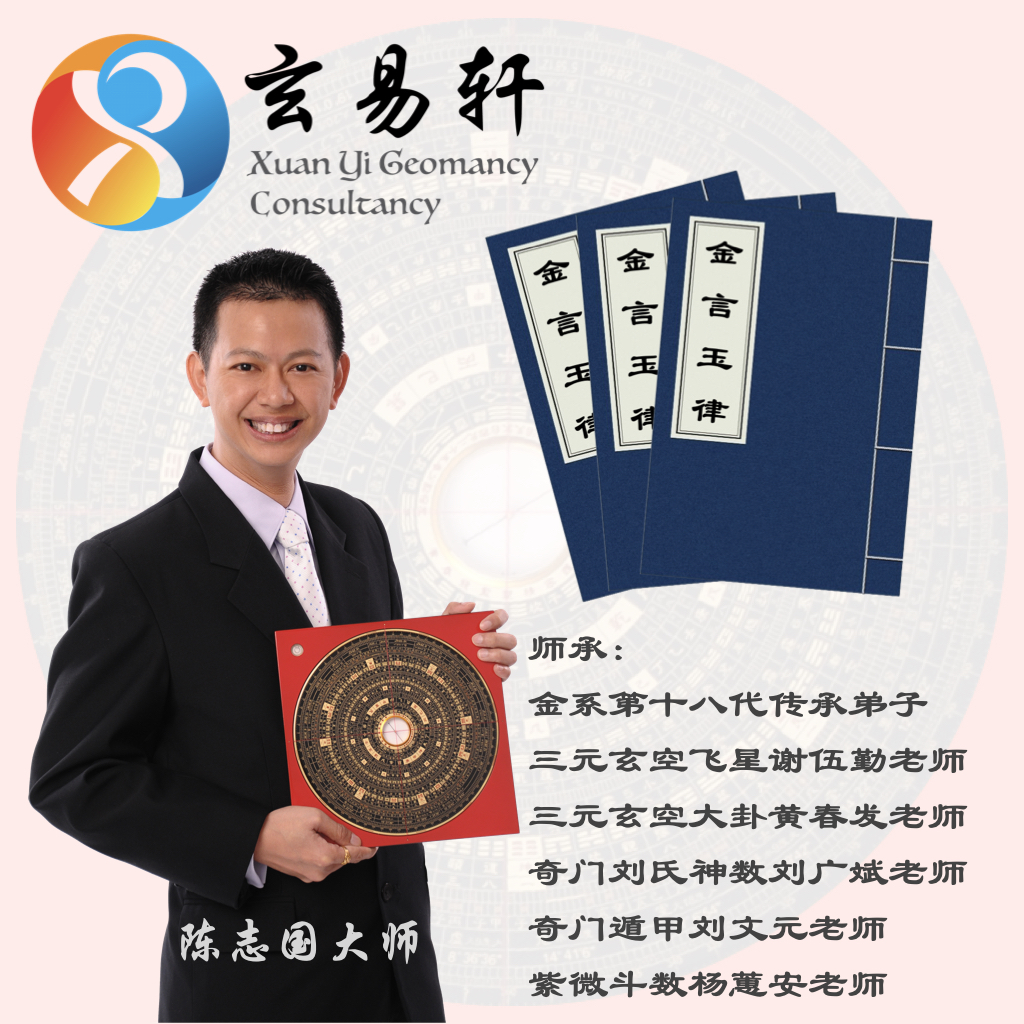风水传承
Our Fengshui Lineage encompass numerology(数), principles(理), forms(象), and divination(占), constituting the four major subjects of Fengshui.
- Numerology: This involves the numbers from one to nine, based on the He Tu and Luo Shu diagrams. Nine corresponds to the element of Metal, hence “金” (jin or gold) takes the first place.
- Principles: This pertains to the principles of the Yi Jing (I Ching or Book of Changes), which is the foundation of Fengshui knowledge. However, Feng Shui cannot be successful without practical application, hence “言” (yan or speech) is next in importance.
- Forms: This refers to the visual aspects. It’s about the shapes and forms that occur naturally in the heavens and on earth. These forms can be classified as auspicious or inauspicious, with “玉” (yu or jade) symbolizing auspiciousness.
- Divination: This relates to the practice of divination. Changes in natural phenomena, such as the heavens, earth, thunder, wind, water, fire, mountains, and rivers, as well as the movements of the sun, moon, and stars, plants and trees, and the fluctuations of seasons, all follow certain rules. Hence, “律” (lu or law) concludes the four subjects.
The meaning of “Jin” lies in these four aspects. As geomancers, we must also maintain self-discipline. The exact origins of our lineage, the identity of our earliest teachers, and ancestral figures are challenging to trace. If we consider 30 years as a generation, our earliest known ancestor should date back to the early Ming Dynasty. According to my grand-teacher, Master Wang Qinsong, our lineage arrived in Taiwan during the Qing Dynasty’s Qianlong reign, led by Lin Banxian from Tangshan, who settled in the ancestral home of Master Qiming. It was then passed down through generations, with Master Qiming as the twelfth generation, my grandfather as the thirteenth, my father as the fourteenth, Master Qiming as the fifteenth, Master Wang Qinsong Xian as the sixteenth, and our esteemed teacher, Master Huang Chunfa, as the seventeenth. It has been passed down to me as the eighteenth generation, and I will pass it on as the nineteenth generation.
The “Jin” four-word tradition does not prioritize “金” (jin or gold) over “律” (lu or law). We all belong to the same lineage, but each branch of the tradition may emphasize different aspects, such as numerology, principles, forms, or divination.

台湾林半仙「金系」堪舆法脉
金言玉律者,数、理、象、占也!为堪舆学之四大课题。
一)数者:河图洛书之数,自一至九也!九属天,其数九为金,故以「金」为首。
二)理者:易理也!易理为堪舆学之源,而堪舆非用口授不为功,是故以「言」次之。
三)象者:形象也!在天成象,在地成形,而形象有美恶之别,以美如「玉」为吉也。
四)占者:占卜之意也!天地、雷风、水火、山泽,日月星辰、山川草木、寒暑往来,自然景象之变化均有定律,故以「律」为末。
金言玉律其意在此,身为地师更要律己。本门源自何时、那位先师、祖师爷是何人已经无从考究。如以30年为一代,往前推算祖师应该是明初人。根据师公王琴松仙师讲述,本门在清朝乾隆年间,由唐山林半仙渡海去到台湾,落脚于启明仙师之祖家。之后传于启明仙师之祖为第十二代,公为十三代,父为第十四代,启明仙师第十五代,王琴松仙师第十六代,恩师黄春发老师第十七代。之后传于我为第十八代。我往下传为第十九代也。 金言玉律四字脉,不是以金字为大,律字为小。我们同样出自同一师门。只不过四字各脉所学有些差异;或偏重数理、或重形象、或重占法而已。
Views: 13
